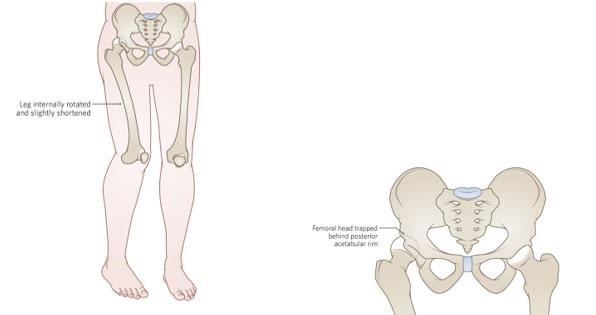A client is brought to the emergency department by ambulance after stepping in a hole and falling. During the assessment, the nurse notes that the right leg is shorter than the left leg the right hip is noticeably deformed and acute pain is noted. Imaging does not reveal a fracture. What is the most likely explanation for this client's signs and symptoms?
Right hip dislocation
Right hip contusion
Right hip strain
Right hip osteoarthritis
The Correct Answer is A
A. Right hip dislocation: In a hip dislocation, the head of the femur is forced out of the acetabulum, which is the socket in the pelvis. This can cause a noticeably shorter leg, hip deformity, and acute pain. Imaging might not show a fracture in the case of a dislocation.
B. Right hip contusion: A hip contusion is a bruise on the hip, usually caused by a direct blow or trauma. While it can cause pain and swelling, it typically does not result in a noticeably shorter leg or hip deformity.
C. Right hip strain: Hip strain refers to damage to the muscles or tendons around the hip joint due to overuse or sudden twisting movements. While it can cause pain, it does not typically lead to a noticeable leg shortening or hip deformity.
D. Right hip osteoarthritis: Osteoarthritis is a degenerative joint disease that can affect the hip joint. It leads to joint pain and stiffness but does not usually cause a noticeable leg shortening or acute deformity unless there are severe complications, which are not mentioned in the scenario.

Nursing Test Bank
Naxlex Comprehensive Predictor Exams
Related Questions
Correct Answer is ["500"]
Explanation
To calculate the infusion rate in ml/hr for a 500 ml bolus to be administered over 1 hour, you can simply set the pump to deliver the entire volume in the specified time:
500 ml / 1 hour = 500 ml/hr
So, the pump should be set at 500 ml/hr to administer the 500 ml bolus over 1 hour.
Correct Answer is B
Explanation
A. Use Echinacea to manage joint pain:
Echinacea is a natural supplement, but its effectiveness in managing joint pain related to osteoarthritis is not well-established. It's important for individuals to consult their healthcare provider before using any supplements, as they may interact with medications or have other adverse effects.
B. Maintain a recommended body weight.
Maintaining a healthy body weight is an important recommendation for managing osteoarthritis. Excess weight puts additional stress on weight-bearing joints, such as knees and hips, which can worsen osteoarthritis symptoms. Losing weight, if necessary, or maintaining a healthy weight can help reduce joint pain and improve mobility in individuals with osteoarthritis.
C. Apply ice to the joint before exercising:
Applying ice can help reduce inflammation and provide pain relief, but it's typically used after exercising or during acute flare-ups, not necessarily before exercising. Heat is often recommended before exercise to warm up the joint and improve flexibility.
D. Reduce the amount of purine in the diet:
This recommendation is more relevant for managing gout, a different type of arthritis caused by the buildup of uric acid crystals in the joints. Purine-rich foods can trigger gout attacks but are not directly related to osteoarthritis. Osteoarthritis is primarily related to wear and tear of the joints over time.
Whether you are a student looking to ace your exams or a practicing nurse seeking to enhance your expertise , our nursing education contents will empower you with the confidence and competence to make a difference in the lives of patients and become a respected leader in the healthcare field.
Visit Naxlex, invest in your future and unlock endless possibilities with our unparalleled nursing education contents today
Report Wrong Answer on the Current Question
Do you disagree with the answer? If yes, what is your expected answer? Explain.
Kindly be descriptive with the issue you are facing.
